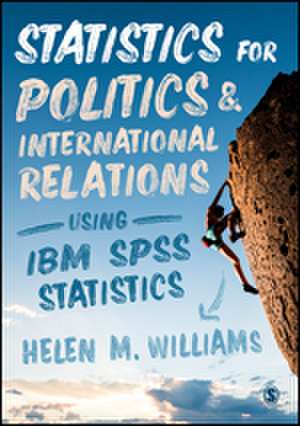Statistics for Politics and International Relations Using IBM SPSS Statistics
Autor Helen Williamsen Limba Engleză Electronic book text – 16 feb 2020
Key features include:
- Software-specific sections in each chapter to show you how to use SPSS, while mathematical equations are kept to a minimum
- Packed with real life examples
- Extensive learning features including: chapter objectives, boxed summaries, illustrations, exercises and end-of-chapter questions, suggestions of further reading and a glossary
- Accompanied by a collection of online resources including datasets, exercises, multiple choice questions, podcasts, videos and further reading and weblinks.
Preț: 207.58 lei
Nou
Puncte Express: 311
Preț estimativ în valută:
35.05€ • 36.98$ • 29.21£
35.05€ • 36.98$ • 29.21£
Indisponibil temporar
Doresc să fiu notificat când acest titlu va fi disponibil:
Se trimite...
Preluare comenzi: 021 569.72.76
Specificații
ISBN-13: 9781526452009
ISBN-10: 1526452006
Pagini: 408
Dimensiuni: 170 x 242 mm
Ediția:1
Editura: SAGE Publications
Colecția Sage Publications Ltd
Locul publicării:London, United Kingdom
ISBN-10: 1526452006
Pagini: 408
Dimensiuni: 170 x 242 mm
Ediția:1
Editura: SAGE Publications
Colecția Sage Publications Ltd
Locul publicării:London, United Kingdom
Recenzii
Dr Williams’ book is an excellent and scary-free introduction to statistics. Using engaging examples from politics and international relations help to illustrate difficult, abstract concepts, making learning statistics fun and approachable. A must-read for all politics undergraduate students!
Anja Neundorf, Professor of Politics and Research Methods, University of Glasgow.
This book boldly outlines existing issues with the teaching statistical analysis to scholars of Politics and International Relations who often lack formal Maths and statistics training and, therefore, are rarely at ease with methodologically heavy ways of teaching statistics and quantitative data analysis. Instead, this book offers an application-based approach to teaching quantitative data analysis that is meant to inspire, as well as educate scholars with little to no background in statistical analysis.
By using relevant Politics and IR examples from a range of reliable data sources and exploring them using simple and robust data analysis techniques, this book makes statistical analysis accessible to a wide range of scholars and encourages their independent learning by offering a range of activities and additional resources for every chapter.
Dr Ekaterina Kolpinskaya is Lecturer in Politics at the University of Exeter.
Anja Neundorf, Professor of Politics and Research Methods, University of Glasgow.
This book boldly outlines existing issues with the teaching statistical analysis to scholars of Politics and International Relations who often lack formal Maths and statistics training and, therefore, are rarely at ease with methodologically heavy ways of teaching statistics and quantitative data analysis. Instead, this book offers an application-based approach to teaching quantitative data analysis that is meant to inspire, as well as educate scholars with little to no background in statistical analysis.
By using relevant Politics and IR examples from a range of reliable data sources and exploring them using simple and robust data analysis techniques, this book makes statistical analysis accessible to a wide range of scholars and encourages their independent learning by offering a range of activities and additional resources for every chapter.
Dr Ekaterina Kolpinskaya is Lecturer in Politics at the University of Exeter.
Cuprins
Chapter 1: Introduction
Chapter 2: Approaches to the social world
Chapter 3: Getting started with SPSS
Chapter 4: Describing Categorical Data
Chapter 5: Visualizing categorical data
Chapter 6: Inference with categorical data
Chapter 7: Describing continuous data
Chapter 8: Visualizing continuous data
Chapter 9: Comparing group means
Chapter 10: Inference with continuous data
Chapter 11: Writing about data
Appendix: Activity answers
Chapter 2: Approaches to the social world
Chapter 3: Getting started with SPSS
Chapter 4: Describing Categorical Data
Chapter 5: Visualizing categorical data
Chapter 6: Inference with categorical data
Chapter 7: Describing continuous data
Chapter 8: Visualizing continuous data
Chapter 9: Comparing group means
Chapter 10: Inference with continuous data
Chapter 11: Writing about data
Appendix: Activity answers
Descriere
Written specifically for Politics and IR students, with subject-specific guidance and examples, this book provides students with a step-by-step introduction to quantitative methods using SPSS
